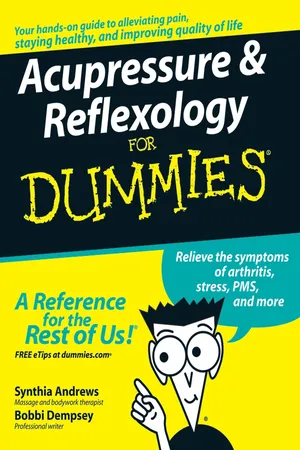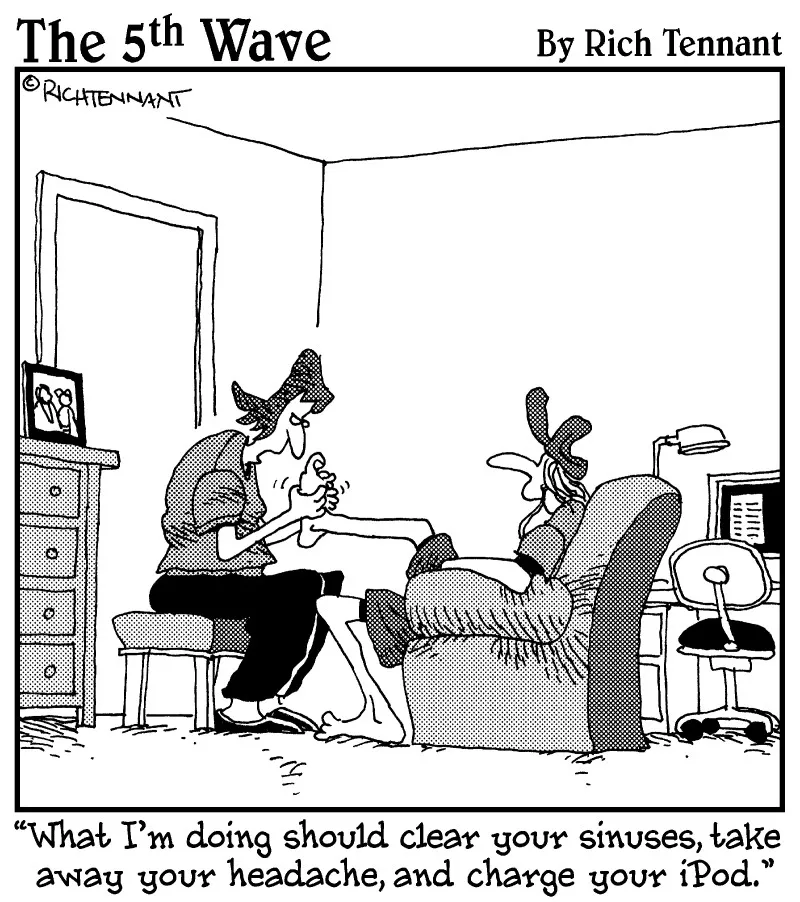
- English
- ePUB (mobile friendly)
- Available on iOS & Android
eBook - ePub
Acupressure and Reflexology For Dummies
About this book
Features healing routines and illustrations to guide you
Ease your aches and find relief through the power of touch
Searching for alternative treatments for pain? This friendly, do-it-yourself guide introduces you to the basics and benefits of acupressure and reflexology, showing you step by step how to nurture your emotional and physical well-being and that of someone else. You'll see how to target specific body parts to address your ailments and improve your emotional as well as your physical well-being.
- Understand basic healing principles
- Relieve your specific aches and pains
- Boost your immune system
- Address age-related ailments
- Find professional help
Frequently asked questions
Yes, you can cancel anytime from the Subscription tab in your account settings on the Perlego website. Your subscription will stay active until the end of your current billing period. Learn how to cancel your subscription.
No, books cannot be downloaded as external files, such as PDFs, for use outside of Perlego. However, you can download books within the Perlego app for offline reading on mobile or tablet. Learn more here.
Perlego offers two plans: Essential and Complete
- Essential is ideal for learners and professionals who enjoy exploring a wide range of subjects. Access the Essential Library with 800,000+ trusted titles and best-sellers across business, personal growth, and the humanities. Includes unlimited reading time and Standard Read Aloud voice.
- Complete: Perfect for advanced learners and researchers needing full, unrestricted access. Unlock 1.4M+ books across hundreds of subjects, including academic and specialized titles. The Complete Plan also includes advanced features like Premium Read Aloud and Research Assistant.
We are an online textbook subscription service, where you can get access to an entire online library for less than the price of a single book per month. With over 1 million books across 1000+ topics, we’ve got you covered! Learn more here.
Look out for the read-aloud symbol on your next book to see if you can listen to it. The read-aloud tool reads text aloud for you, highlighting the text as it is being read. You can pause it, speed it up and slow it down. Learn more here.
Yes! You can use the Perlego app on both iOS or Android devices to read anytime, anywhere — even offline. Perfect for commutes or when you’re on the go.
Please note we cannot support devices running on iOS 13 and Android 7 or earlier. Learn more about using the app.
Please note we cannot support devices running on iOS 13 and Android 7 or earlier. Learn more about using the app.
Yes, you can access Acupressure and Reflexology For Dummies by Synthia Andrews,Bobbi Dempsey in PDF and/or ePUB format, as well as other popular books in Medicine & Alternative & Complementary Medicine. We have over one million books available in our catalogue for you to explore.
Information
Part I
Touching on the Basics of Acupressure and Reflexology

In this part . . .
Part I gives you all the important essentials you need to know about acupressure and reflexology. Think of this as your Healing 101 introductory course.
We explain exactly what acupressure and reflexology are, and what they mean to anyone who needs emotional and/or physical healing. We fill you in on the history of the healing arts and the meaning of qi. We tell you what you need to heal yourself and others — your own two hands and confidence in yourself — and give you a little pep talk to strengthen your faith in your innate ability to heal.
Finally, we review the anatomical concepts that you need to know in order to properly perform the techniques in this book. You become familiar with the meridians, acupoints, reflex zones, different types of tissue, and other body parts that play an important part in the healing process. Unless you already have some massage training, we strongly suggest that you read this part so that you know all the basics.
Chapter 1
Acupressure and Reflexology Essentials
In This Chapter




If you’re like most people, you know little (if anything) about acupressure and reflexology. You may incorrectly believe that acupressure involves needles. It doesn’t — but don’t worry, we address that and other misconceptions in the next few chapters. And when thinking about reflexology, you may guess from the name that it involves your reflexes in some way, but that may pretty much be the extent of your insight on the topic.
Or perhaps you do have some knowledge of the healing arts. You may know, for example, that a basic tenet of these approaches is the idea that pain can often be traced back to its root, which is often some distance away from the place where the pain is felt. However, you may not know exactly what that is, or how to trace the source of your pain.
Regardless of your knowledge level, or your reason for wanting to discover more, you can definitely benefit from reading about these important approaches to healing. Bodywork is beneficial to almost everyone, and it’s often helpful if you know the background behind the techniques.
In this chapter, you explore the roots of reflexology and acupressure. You find out about the fundamental principles involved, including the concept of qi. Finally, and perhaps most importantly, you discover how these approaches to healing can help you. No matter what your physical ailment or health concern, you’ll probably be pleasantly surprised at the difference even a minimal amount of bodywork can make.
Acupressure and Reflexology Defined
Before you get too far into the healing routines and practices that we discuss in this book, you need to make sure that you understand exactly what acupressure and reflexology are. They’re closely related, and in much of this book we refer to them jointly as a pair of complementary healing arts. But despite their similarities, they do have some differences.
Acupressure
Acupressure is an ancient healing art that entails using an object (generally the hands or arms) to stimulate specific key points on the body with the goal of relieving pain or discomfort. Pain and discomfort are considered to be signs of energy imbalance, which, if left in this state, will become illness and disease.
Acupressure approaches this energy imbalance in a concrete way through the identification of acupoints. Acupoints are located on meridians, or channels that run throughout the body and connect all parts of the body together. These acupoints are specific sites on the body that often treat pain or discomfort elsewhere. By addressing problems or imbalances at the acupoints, you can balance the flow of energy and thereby reduce or eliminate pain in the affected areas.

Eunice Ingham: Reflexology’s patron saint
Reflexology first began catching on in the United States in the early 1900s. This was due in large part to a woman named Eunice Ingham. Eunice was a massage therapist who worked in the 1920s for a man named Joe Shelby Riley. Dr. Riley was well known as the creator of the Zone Theory, which is often seen as the precursor to modern-day reflexology. Inspired by Dr. Riley, Eunice expanded on the ideas of zone therapy while focusing on only one zone, the feet. She published her first book on the topic, called Stories the Feet Can Tell, in 1938. Soon Eunice became an in-demand teacher and lecturer who was often asked to share her knowledge of healing therapies. Eventually, she was joined by her nephew, Dwight Byers, who went on to become the founder of the International Institute of Reflexology.
Reflexology
Reflexology is a system of healing based on balancing energy by stimulating areas in the feet and hands that relate to organs, glands, and parts of the body. Reflexology is similar to acupressure in basic principle, but the two have some differences as well. They both correct imbalances in the energy force by focusing on specific areas of the body where they pinpoint (and treat) that imbalance. Although acupressure involves meridians and acupoints, reflexology relies on pathways called reflex zones, which contain reflex areas located on the hands and feet. The reflex areas on the hands and feet are essentially holograms of the whole body; therefore, stimulating the hands and feet affects the whole body. By applying pressure to specific reflex points, you adjust the flow of energy and can create a positive response (reduced pain) in a corresponding location elsewhere on the body.
Digging Deeper into Origins and Philosophy
Many healing arts, including acupressure and reflexology, are based on the beliefs of Chinese energy medicine — which people first practiced more than 5,000 years ago. The ancient Chinese believed that spiritual imbalances caused many illnesses and physical ailments. In order to effectively address the pain, the Chinese believed, you needed to resolve your spiritual imbala...
Table of contents
- Title
- Contents
- Introduction
- Part I : Touching on the Basics of Acupressure and Reflexology
- Part II : Promoting Emotional and Physical Wellness
- Part III : Where Does It Hurt? Treating Common Aches and Ailments
- Part IV : Addressing Specific Needs and Concerns
- Part V : The Part of Tens
- : Further Reading